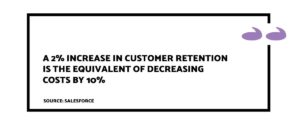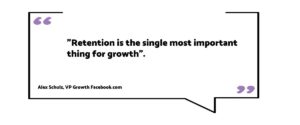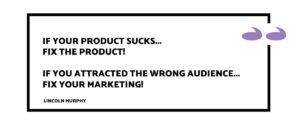09 Jun The Art of Customer Retention
As the world slowly starts to reopen, whether B2B or B2C most industries are witnessing a cautious restart. Business is starting to bounce back, and pipelines are filling up, but new customers are likely to be a little more difficult to find than normal – for now at least.
Our post-pandemic scenario and the increasing costs of acquiring new customers means that customer loyalty and the resulting customer retention has never been more important. Unfortunately, younger companies who are out grabbing new opportunities and growing quickly, or sheltering in place to ride out the pandemic, often overlook customer retention and loyalty programmes amid the prize of new business or quick fix cost reduction.

Your existing customer base, especially those who have shown loyalty and made repeat purchases are more likely to be interested in your newest products and services, and often represent the quickest, cheapest route to increase your brand revenue. Added to that loyal customers are louder and more frequent brand advocates and tend to buy more over time.
Businesses who are best able to retain customers now will be those that understand and support their customers’ current situation and revised outlook. Your customers’ priorities and normal preferences may have shifted. The sooner you tap into their new world reality and how their needs may have changed the sooner and better you can make moves to meet those needs. Customers who feel you’ve adapted to meet their shift in priorities, be that revised payment options, new features, additional time listening to and supporting them will build a positive perception of your brand that resonates long after the current turmoil subsides.
The goal especially now is first and foremost to retain your customers. Simply put, customer retention refers to the activities and actions you can take to engage existing customers to continue buying products or services from you and reduce the number of customers who either defect or simply stop buying at all. Some of the current shifts in customer requirements may be temporary, some will potentially change permanently. More than ever your buyers are looking for brands they can trust. Brands that stand up and meet their brand values. Brands that make a positive difference.
Business Case for Focusing on Customer Retention
- Starting with the obvious, it keeps your customers from defecting to your competition
- According to HBR it’s anywhere between 5 and 25 x MORE EXPENSIVE to acquire a new customer that it is to retain an existing one.
- Wins you a bigger share of your customers purchases as they choose you over alternative options
- SignalMind reports the success rate of selling to an existing customer is between 60 and 70%, while the probability of a sale to a new customer is a mere 5-20%!
- Prompts your customers to make additional purchases they wouldn’t otherwise have made.
- Research by Fred Reichheld of Bain & Company shows that increasing customer retention rates by five percent increases profits by between 25% and a whopping 95%.
- It makes sense that a customer who knows you, trusts you, likes you and is already set up to deal with you will be more willing to spend money with you and sure enough returning customers typically spend 33% more than new customers.
- A 2% increase in customer retention is the equivalent of decreasing costs by 10% according to research by Salesforce
- Customer retention also provides a good base for sales forecasting. If you can count on loyal customers returning in the next quarter, anticipatory budgets become more reliable and decisions based on more stable sales budgets become easier to make.
Against this backdrop it’s easy to see why companies are making customer retention a strategic objective and why so many are launching or re-launching their loyalty programmes. Loyalty programmes are important but they’re only one part of a good customer retention strategy.

Strategies for Customer Retention
Before we look at retention strategies it’s worth pausing to state the obvious. Regardless of what else you do quality and customer service are cornerstones of doing business that are not only highly valued by your customers, they are essential. Quality and service remain the make or break starting point of any expectations you have of customers returning to do business with you again.
Once we have your customer in the position of making a purchase from you then customer retention has one goal: to remove as many reasons for an of your customers to stop trading with you as possible.
Customer success
Make sure your customers achieve the result they were looking for when they purchased your product/service.
Customer care and support
Get the basics right and ensure that any issue that does arise with your service or product is addressed quickly and effectively and that your customer beyond satisfied with your response.

Overcome buyers’ remorse
Buyers’ remorse is the “Should I have really done that?” moment we’ve all experienced from time to time after the initial thrill of making a purchase subsides. It’s a natural human tendency backed by lots of human behavioural psychology. In a B2B environment it’s a relatively easy fix simply by reducing the time lag between sales and operations. In management consulting and software implementations it’s usual for the handover to be immediate so that the project activity starts as soon as the sale is agreed with the forward momentum leaving little time or opportunity for rumination. In other B2B scenarios a Customer Success Manager is given an immediate “warm handover” from sales and the “onboarding process” occupies the space as again forward momentum takes the place of a backward looks. Depending on the business you are in (Himalayan twilight hang gliding adventure) you may not expect much customer return, for others though this is start of building a lifetime customer. Either way this is the time to reach out, make a call, write a letter, or send a video. You need to keep in touch with the customer about their purchase and assure them you are there to help, remind them when it will arrive, and anything else to show you haven’t abandoned them once you have their money. For those who don’t expect return visitors you want them to find your next visitors for you. The better your interaction and connection with customers at this time the more you can turn the potential of buyers’ remorse into customer loyalty.
Post-sale marketing
Don’t be scared of this one! As we mentioned above ongoing engagement is crucial to your retention strategy. Give your customers the attention they crave. Listen to their voice and predict their needs and wants. Quality, relevant communication is warmly welcomed by fans of your product or service.
- Affirm their decision, make them feel good about their decision and that you care about them, not just their money.
- Activate their usage, depending on what you’re selling it may be days, weeks or even months before their purchase arrives. When it does you want them to start using it right away. You know when it arrives so get in touch.
- Guide customers on how to use your product or service. Make sure they don’t just use the basics. Help them to get the most out of their purchase by using all the features. TIP: listen and learn if they are using your product for something other than its original intention!
- Celebrate when they accomplish the reason for buying from you. Satisfied customers arise when they resolve their issue or accomplish their objective. Help them get there, then remind them to enjoy the moment.
Customer differentiation to find customer value
Of course, not every customer is going to be highly profitable and stay with you for the long haul. Customer differentiation and targeting allow you to identify which customers fall into the group with potential for the greatest value. Then you can target your relationship-building. Harvard Business School’s ‘Managing Churn to Maximize Profit’, recommends that rather than redirecting time and resources to retaining any and all customers, businesses should focus their limited resources and attention on the most profitable customers.
Maintaining the relationship
The relationship with your customers only begins with the sale. Maintaining a strong relationship with customers is necessary to increase retention. Once you’ve identified who your high potential customers are, then it’s about developing an ongoing and lasting relationship based on attractive proposals that adapt to your customers different profiles and preferences in a profitable way. It’s a question of making the right proposals to them at the right moment and being capable of both maintaining the customer’s interest and strengthening their bond with your brand. We are facing unprecedented times now and it’s never been more relevant to understand everything that’s happening to your customers, whether it’s the purchasers and influencers within a B2B scenario or direct to your final consumer.
- How was your customer’s routine impacted?
- Where are they at in the return to “normal”?
- What can you do to help them face the new situations they are dealing with?
Personalisation
Understand your individual customers’ needs and engage with them based on what you know about them including their preferences and personality. Make sure everyone in your company who is likely to interact at any point of the customers’ journey has access to it. For continuity and a consistent experience with your business it’s vital your team all know about each customer’s objectives and expectations. You know from your own experiences that there’s nothing worse than call a business you buy from and having to restart your explanation over and over again. There are no excuses not to do this. With shared cloud options, and free CRM options available, even the smallest start-ups can make this happen with a little effort.
Loyalty programs
There’s a simple reason why big businesses run customers programmes even though they can be notoriously hard to get right. It’s because they work! Get your loyalty programme up and running and the results can be astonishing.
(We will be releasing another blog with tips on the how and how not of loyalty programmes shortly. )
Now start
You can see that there are many different actions you can take now to build your customer retention. There has literally never been a better time to approach your customers and genuinely listen and learn. Gain insight, answer their needs, build trust, and let them know how much you value them. The key of all this is to start putting the ideas into action, measure them across the shortest meaningful time frame for your business and you should start to see results.
FOR MEMBERS WE’LL BE GOING INTO MORE DETAIL ON CHURN MODELLING AND METRICS IN NEXT MONTHS DOWNLOAD

